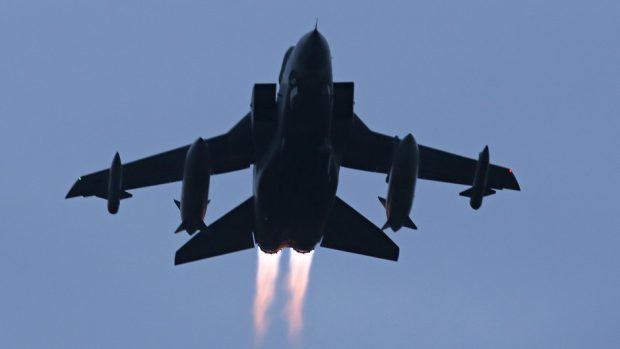RAF planes fired Brimstone missiles on Islamic State targets in Syria for the first time over the weekend.
Tornados and unmanned Reaper drones were involved in four missions on Sunday.
Among the targets was the Omar oil field in the east of the country, near the Iraqi border.
According to the Ministry of Defence (MoD), Brimstone weapons – estimated to cost around £100,000 each – were used to take out mobile cranes brought in by IS to repair damage inflicted by previous strikes on the field.
The attack, during which the prime minister’s spokeswoman said three Brimstones were deployed, was carried out by two
Tornados and a Reaper drone and also involved Hellfire missiles.
In a separate mission, two Tornado jets used a Brimstone missile to take out an IS supply truck, near the town of Raqqa.
They also targeted two IS-held buildings, one of which was a confirmed command and control centre, with Paveway IV laser-guided bombs.
A second pair of Tornados dropped four Paveway IVs on an enemy tunnel complex, again near Raqqa, while Reapers attacked a terrorist position with a Hellfire missile.
In recent weeks, the RAF’s emphasis has been on Iraq, particularly efforts to retake Ramadi, but on Sunday focus shifted to Syria.
The prime minister’s spokeswoman said the missions were part of the ongoing operation with coalition partners to defeat IS in Iraq and Syria.
She added: “We have always been clear that is going to take time.”
She said she could not comment on casualties, adding only that the focus was on “Daesh terrorists and their resources”.
She also pointed to the clear military guidelines in place on targeting and striking.
Asked why the decision was taken to use the Brimstone missiles, she said that was an operational matter for the RAF, but
highlighted their specific capabilities.
She added: “It was judged that for this type of targets this was the weaponry needed.”
The MoD said it could not confirm whether or not the Tornados that took part were from RAF Lossiemouth.
Brimstone is a “fire-and-forget” radar-guided precision weapon which can be used against moving targets.
David Cameron referred to it in the run-up to last month’s vote on war in Syria as the kind of UK asset which would make a “meaningful difference” to the coalition’s battle against IS.
Meanwhile, yesterday morning, a Reaper drone flew the 1,000th sortie by that kind of craft against IS since they were committed to operations in October 2014.
Typhoons were engaged in operations over Ramadi on Thursday, but not involved in the weekend’s attacks.
